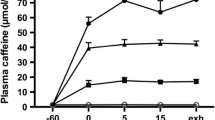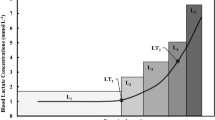Summary
It has been hypothesized that chronic hypobaric hypoxia could lead to inhibition of theα-motoneuron pool, thus limiting the maximal activation of working skeletal muscles. To test this hypothesis six subjects [32 (SEM 2) years] were evaluated in resting conditions, at sea level and after acclimatization at 5,050 m. The recruitment curves of the Hofmann-reflex (H-) and the direct muscle-response (M-) of the right soleus muscle were obtained by stimulating the posterior tibeal nerve with different intensities while recording the electromyogram of the soleus muscle. From the recorded data the netα-motoneuron excitability (ratio of maximal H-reflex to M-response Hmax : Mmax ratio), the threshold and gain for both responses, obtained from linear regressions through the rising phase of the recruitment curves of both responses, as well as the latency times of both responses were determined. The latency times and the Hmax :Mmax ratio were unchanged at altitude. The thresholds of both responses and the gain of the M-response were unaltered. The gain of the H-response was significantly higher at altitude when compared to sea level. It is concluded that in the acclimatized subjects at rest the signal conduction velocity through the different parts of both pathways was unaltered and therefore nerve and muscle conduction velocity as well as synaptic and muscle end-plate transmission were unchanged, that the recruitment of the H-reflex was slightly facilitated after acclimatization to high altitude suggesting increased excitability of theα-motoneurons, through either postsynaptic facilitatory changes in the soma or a different descending drive, and that the unchanged Hmax:Mmax ratio indicated no change in the net excitatory and inhibitory influences on theα-motoneuron pool. The above hypothesis is thus not strengthened by the results that were, however, obtained in resting conditions.
Similar content being viewed by others
References
Angel RW, Hofmann WW (1963) The H-reflex in normal, spastic and rigid subjects. Arch Neurol 8:591–596
Bigland-Ritchie B, Vollestadt NK (1988) Hypoxia and fatigue: how are they related? In: Sutton JR, Houston C, Coates G (eds) Hypoxia, the tolerable limits. Benchmark Press, Indianapolis, Ind., pp 315–326
Dhand UK, Das SK, Chopra JS (1991) Patterns of H-reflex abnormality in patients with low back pain. Electromyogr Clin Neurophysiol 31:209–213
Garland SJ, McComas AJ (1990) Reflex inhibition of human soleus muscle during fatigue. J Physiol (Lond) 429:17–27
Garner SM, Sutton JR, Burse RL, McComas AJ, Cymerman A, Houston CS (1990) Operation Everest II: neuromuscular performance under conditions of extreme simulated altitude. J Appl Physiol 68:1167–1172
Gerilovsky L, Karadimov K, Ianakier B (1991) Hypoxia reduces the conduction velocity of the excitation along the striated muscles in man. Electromyogr Clin Neurophysiol 31:203–208
Hugon M (1973) Methology of the Hofmann reflex in man. In: Desmedt YE (ed) New developments in electromyography and clinical neurophysiology, vol. 3. Karger, Basel, pp 277–293
Miller RG, Giannini D, Milner-Brown HS, Layzer RB, Koretsky AP, Hooper D, Weiner MW (1987) Effects of fatiguing exercise on high-energy phosphates, force, and EMG: evidence for three phases of recovery. Muscle Nerve 10:810–821
Narici M, Bordini M, Binzoni T, Kayser B (1991) Adductor pollicis muscle contractility and fatigue during high altitude exposure. Proceedings of the International Congress on Mountain Medicine in Crans-Montana, April 1991. Schoechli, Sierre, p 24
Narici M, Kayser B, Cibella F, Grassi B, Cerretelli P (1992) No changes in body composition and maximum alactic anaerobic performance during a 4-week sojourn at altitude. Int J Sports Med 13:87
Paillard J (1955) Reflexes et regulations d'origine proprioceptive chez l'homme. Arnette, Paris
Schieppati M (1987) The Hofmann reflex; a mean of assessing spinal reflex excitability and its descending control in man. Prog Neurobiol 28:345–376
Schmeling WT, Forster HV, Hosko MJ (1977) Effect of sojourn at 3200 m altitude on spinal reflexes in young adult males. Aviat Space Environ Med 48:1039–1045
Verrier MC (1985) Alterations in H-reflex magnitude by variations in baseline EMG excitability. Electroencephalogr Clin Neurophysiol 60:492–499
Willer JC, Miserocchi G, Gautier H (1987) Hypoxia and monosynaptic reflexes in humans. J Appl Physiol 63:639–645
Author information
Authors and Affiliations
Rights and permissions
About this article
Cite this article
Kayser, B., Bökenkamp, R. & Binzoni, T. Alpha-motoneuron excitability at high altitude. Europ. J. Appl. Physiol. 66, 1–4 (1993). https://doi.org/10.1007/BF00863391
Accepted:
Issue Date:
DOI: https://doi.org/10.1007/BF00863391




